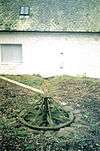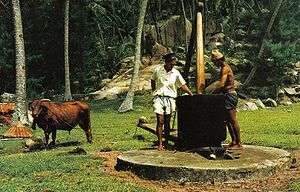Horse mill

A horse mill is a mill, sometimes used in conjunction with a watermill or windmill, that uses a horse as the power source. Any milling process can be powered in this way, but the most frequent use of animal power in horse mills was for grinding grain and pumping water. Other animal engines for powering mills are powered by dogs, donkeys, oxen or camels. Treadwheels are engines powered by humans.
In Antwerp, Belgium, the Brewers' House museum[1] is a good example of horse-powered pumping machinery. The building dates from the 16th century; although the original wooden machinery was replaced in cast iron in the mid-19th century, the original layout has been retained.
Gallery
 The Horse Mill at Wester Kittochside Farm near Glasgow
The Horse Mill at Wester Kittochside Farm near Glasgow A bullock-powered mill, Seychelles
A bullock-powered mill, Seychelles.jpg) The olive grinding mill, High Atlas (Morocco)
The olive grinding mill, High Atlas (Morocco) A horse-powered threshing machine.
A horse-powered threshing machine.
The horse and harness nearest the viewer have been omitted to show the machinery.
Horse mill at Beamish Museum
This horse mill has not been used since about 1830 when it was superseded by portable engines. It was rescued from Berwick Hills Low Farm in Northumberland by the museum, repaired and set up in their own gin gang at Home Farm as a non-functioning exhibit. The top of the mill's main vertical axle and the end of the main drive shaft are pivoted at the centre of their own separate tie beam which is below and parallel with the main roof tie beam, and set in the gin gang's side walls at either end. The mill's tie beam has to be stabilised with two massive oak beams which run, either side of the drive shaft, from tie beam to threshing barn wall. A large and basic engine like this can create great stresses from the torque engendered.[2]

 Housing for top pivot of main axle, bolted to its own tie beam, separate from roof truss (visible above)
Housing for top pivot of main axle, bolted to its own tie beam, separate from roof truss (visible above) Drive shaft gear resting on main horizontal gear wheel which is attached to top of main vertical axle of mill
Drive shaft gear resting on main horizontal gear wheel which is attached to top of main vertical axle of mill The two pivots: end of drive shaft (centre) and top of main axle (behind)
The two pivots: end of drive shaft (centre) and top of main axle (behind)
Mill construction
This four-horse mill is based on a central, vertical, heavy, 10 feet (3.0 m) high, oak axle, with its base pivoting on an iron framework set in the middle of the gin gang floor. Its top end pivots under the mill's own tie beam (if it didn't, it would fall over) but the tie beam cannot rest on the pivot, or the mill would not turn. The main axle supports around its top end the main, 6 feet (1.8 m)-diameter, horizontal gear wheel, with the teeth on the top surface. The main drive shaft, a massive oak pole, is girthed at one end by a secondary gear wheel which lies on the main gear wheel, thus turning the main drive shaft on its long axis. The main drive shaft runs from the main gear wheel through a hole in the threshing barn wall and in the barn it powers the threshing machine and other machines via further cogwheels and belts. Such a machine would create great torque stresses, and if it were ever to work again it would require re-engineering to ensure smooth and safe running, and beams which are seasoned and not cracked.[2]
 Main horizontal gear wheel at top of main axle, with drive shaft gear wheel on it. Drive shaft transfers power through threshing barn wall.
Main horizontal gear wheel at top of main axle, with drive shaft gear wheel on it. Drive shaft transfers power through threshing barn wall. Horse shaft fixed to one of four long beams, all braced to each other with stretchers, and each fixed to the side of the top of the main axle.
Horse shaft fixed to one of four long beams, all braced to each other with stretchers, and each fixed to the side of the top of the main axle. One of four long beams, each with horse shaft hanging from it.
One of four long beams, each with horse shaft hanging from it. A four-horse mill requires a large working space
A four-horse mill requires a large working space
Horse power
This is a powerful horse mill for four horses; probably English ponies, as modern heavy horses were not yet fully bred in the 1830s. Each of the four heavy oak beams connecting the central axle to the four horse shafts runs from beside the axle to the under-surface of the main gear wheel, and crosses the other three in a grid pattern between the axle and gear wheel, thus supporting the gear wheel and creating a rigid structure at the same time. They project for many feet beyond the main gear wheel, and require wooden stretchers to stabilise them. From the ends of these beams hang the horse shafts. The bottom ends of these shafts are quite low, which may indicate the use of ponies rather than early heavy horses.[2]
Horse mills still in use
The Noah Hoover Mennonites, an Old Order Mennonite group, that does not allow any engine power at all, still has several horse mills in use, both in the US and in Belize in Central America. The mills are used to power e. g. a sorghum-cane juicer in Scottsville, Kentucky or saw mills in Springfield and Pine Hill, both in Belize.[3][4]
See also
- The International Molinological Society
- Museum of Scottish Country Life
- Lambroughton Titwood Farm Horse Mill
- Donkey Stone
- Edge mill
- Experiment (horse powered boat)
- Gin gang
- Whim (mining)
References
- ↑ Museum Brouwershuis
- 1 2 3 See images in Commons category:Gin gang and Commons category:Horse mill, or for further information contact the agricultural department of Beamish Museum. There is no printed or online citation for this horse mill or building.
- ↑ Horse powered saw mill, Belize at YouTube
- ↑ Visiting Daniel Hoover Mill in Scottsville, KY at YouTube
| Wikimedia Commons has media related to Horse mills. |
- Animal Powered Machines, J. Kenneth Major. Shire Album 128 - Shire Publications 1985. ISBN 0-85263-710-1
- Water-mills windmills and horse-mills of South Africa, James Walton. C Struik Publishers, 1974. ISBN 0-86977-040-3
- "The History of Rochester, New York" by William F. Peck, D. Mason & Co. Publishers 1844